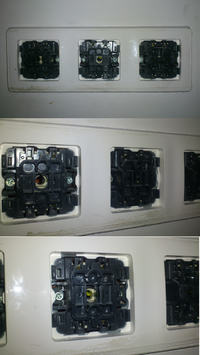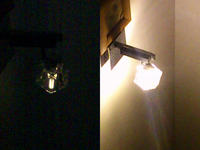Good evening,
I just noticed a strange problem in one of the lighting sconces.
So far I have used G9 230V halogen bulbs, today I bought G9 230V LED bulbs which only allowed me to observe this problem.
Well, despite the fact that I turn off the light in this sconce using the wall switch, there is still some voltage to the sconce and a current flows through the LED bulb plugged into it, causing it to glow slightly (minimal but visible), the plugged in LED bulb lights up despite the light being turned off. After turning on this sconce, the LED lights up as it should only when it is turned off instead of being completely turned off, the current continues to pass through it.
It should not be the fault of the LED bulb because it works properly after plugging the one into other light fittings. Similarly, other LED bulbs that work properly in other light fittings (ON wall switch - led is on, OFF led switch goes out to zero), when connected to this one wall lamp, get these strange symptoms (they shine like they should not). Wall switches are the most ordinary, they do not have any dimmers.
As I wrote before, previously there was a G9 230V halogen lamp in this wall lamp and it was not visible (I think that the current that is able to emit LEDs was not enough for halogen?).
The building is relatively new, the type of network system is either TN-CS or TN-S. I would like to add that the wall lamp in which this happens is connected to two wall switches (it is on the stairs, you can light it upstairs, go downstairs and turn it off at the bottom, etc.).
What could this be happening? Loose wires in wall switches? Manufactured contacts in switches? Any worse installation problem? Only tomorrow will I be able to disassemble this wall lamp, check wall switches, measure the voltage and current. If you need any additional information, I will tell you right away when I know what.
Thank you in advance for your help.
I just noticed a strange problem in one of the lighting sconces.
So far I have used G9 230V halogen bulbs, today I bought G9 230V LED bulbs which only allowed me to observe this problem.
Well, despite the fact that I turn off the light in this sconce using the wall switch, there is still some voltage to the sconce and a current flows through the LED bulb plugged into it, causing it to glow slightly (minimal but visible), the plugged in LED bulb lights up despite the light being turned off. After turning on this sconce, the LED lights up as it should only when it is turned off instead of being completely turned off, the current continues to pass through it.
It should not be the fault of the LED bulb because it works properly after plugging the one into other light fittings. Similarly, other LED bulbs that work properly in other light fittings (ON wall switch - led is on, OFF led switch goes out to zero), when connected to this one wall lamp, get these strange symptoms (they shine like they should not). Wall switches are the most ordinary, they do not have any dimmers.
As I wrote before, previously there was a G9 230V halogen lamp in this wall lamp and it was not visible (I think that the current that is able to emit LEDs was not enough for halogen?).
The building is relatively new, the type of network system is either TN-CS or TN-S. I would like to add that the wall lamp in which this happens is connected to two wall switches (it is on the stairs, you can light it upstairs, go downstairs and turn it off at the bottom, etc.).
What could this be happening? Loose wires in wall switches? Manufactured contacts in switches? Any worse installation problem? Only tomorrow will I be able to disassemble this wall lamp, check wall switches, measure the voltage and current. If you need any additional information, I will tell you right away when I know what.
Thank you in advance for your help.





